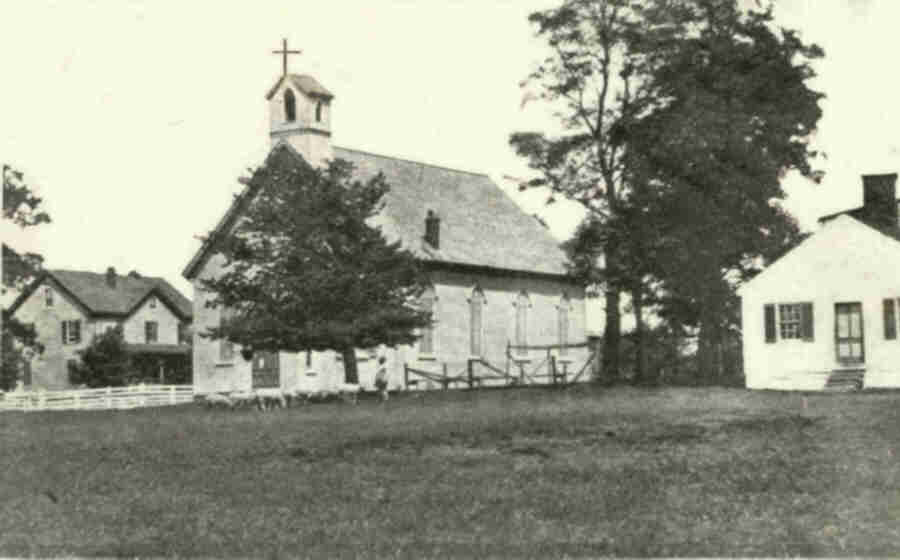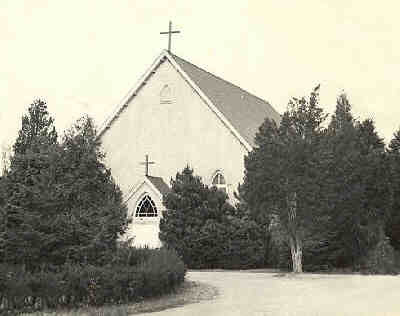St. Peter's Catholic
Church
3320 St. Peter's Drive, Waldorf,
MD 20601-2359
OUR HISTORY
 St.
Peter's Church, Waldorf, Maryland, according to the Catholic Directory
of the Archdiocese of Washington, was established in 1700. It can be found
three miles east of Waldorf. At first it was a mission attached to St.
Ignatius Church at Chapel Point, which is the original Catholic foundation
in Charles County and from which most of the other Catholic churches in
the county took their origin.
St.
Peter's Church, Waldorf, Maryland, according to the Catholic Directory
of the Archdiocese of Washington, was established in 1700. It can be found
three miles east of Waldorf. At first it was a mission attached to St.
Ignatius Church at Chapel Point, which is the original Catholic foundation
in Charles County and from which most of the other Catholic churches in
the county took their origin.
The records of St. Peter's begin with 1852, all previous
records having been kept at Chapel Point. Prior to 1852, the parish was
known as St. Ignatius of Upper Zekiah. (This was because it was located
at the headwaters to the present Zekiah Swamp). It was a sister church
to St. Mary's Lower Zekiah, now Bryantown. Now it was renamed St. Peter's,
Beantown. The first church was located in old St. Peter's Cemetery about
one-quarter mile east of the present location on Poplar Hill Road. The
site of the old cemetery is one that impresses the visitor with a sense
of strength and endurance, as he walks among the age worn tombstones, reading
names of those who labored to build the old frame chapel that was used
for about 150 years.
The immediate area is ripe in history. In 1681, a
fort was built on the Zachia Swamp, about four miles southeast of LaPlata,
to protect the Zachia Indians against the Senecas and Susquehannocks of
the north. To this fort were brought the Piscataways when their village
was in danger of attack from their common enemy. Governor Charles Calvert,
writing to his brother, Lord Baltimore, spoke of his intent to build a
residence "on his Lordship's Manor of Sachay"; in 1673, he wrote that the
house was complete, and he proposed moving from Mattapony to Zachia for
greater security. The word "Zachia," spelled Zacchia, Zachaiah, Zakiah,
Zekiah, or Sachay, means "where there is a bend."
The Jesuit fathers from St. Thomas Manor served the
congregation of Upper Zachia from 1700 to 1792, when Archbishop Carroll
sent Father J. B. David, a Sulpician, and a refugee from the French Revolution,
to care for the congregation. Father Robert Angier, O.P., a Dominican,
was his successor from 1805 to 1807. From that time until 1816, the parish
was cared for by Father John Henry, S.J., a Belgian Jesuit, Father Heath,
S.J., and Father J. B. Cary, S.J. from St. Thomas Manor.
In 1816, Father Angier returned from Europe where
he had gone to solicit financial help for his several parishes, and was
again appointed pastor until 1825. In that year, Father Enoch Fenwick,
S.J., a native of St. Mary's County, was pastor for a short time and was
succeeded by Father J. V. Wiseman, who remained until 1829, when Father
Francis Roloff became pastor until 1838. It was during his pastorate that
the congregation at Piscataway became large enough to form a new parish,
and Monsignor McColgan was appointed pastor. Upper Zachia was then served
from this parish instead of from Bryantown. The village of Piscataway,
an Indian word meaning, "a high passable bank around a river bend," is
about 12 miles west of Waldorf, on the Piscataway Creek."
The record shows that from 1838 to 1851, the congregation
was again served at various times from St. Thomas manor. In 1851, Father
John Donelan was sent by the Archbishop to be the first resident pastor
of St. Ignatius Church, and from then until 1894, the diocesan priests
served the congregation.
In November 1855, Father Donelan sailed for Rome
for the restoration of his health, and Father Lanahan succeeded him as
pastor of St. Ignatius of Upper Zachia. He immediately realized that the
little frame chapel built in 1700 was inadequate to accommodate the congregation.
Our present property was a gift in 1825 of Thomas
C. Reeves, a relative of Dr. Samuel Mudd. Mr. Reeves died on November 28,
1825. The first church on the Reeves property was constructed in 1862 and
was often called "Reeves' Chapel". For many years, the old Reeves residence
functioned as the rectory. The next church on this property was dedicated
in honor of St. Peter the Apostle on August 15, 1860. It was the church
here that John Wilkes Booth passed on his infamous escape from Washington
to the house of Dr. Samuel A. Mudd after the assassination of Abraham Lincoln.
Some of Dr. Mudd's relations are buried in both the old and new cemetery.
The parish was made up mostly of farmers for a good many years. The center
of the second cemetery contains a memorial cross honoring the generous
donor of the property. It contains this inscription: "In memory of Thomas
C. Reeves who left his property to St. Peter's Church. His burial was in
St. Peter's Old cemetery in 1825. Erected by members of St. Peter's Church
in 1941."
 Father
Charles W. Currier was the first pastor of St. Peter's in 1892.
He later became Auxiliary Bishop of Baltimore. The famous Sulpician pastor,
Father
Narcisse Martin, S.S., followed him (1894-1923). Previously,
he had been a professor of Dogmatic Theology at the Grand Seminary in Montreal,
Canada. While he was ranked as one of the few theological geniuses of the
Church in America, he turned from academia to parish work. His Treatise
on the Blessed Sacrament is considered an authoritative theological
work. A man of great zeal, he did much to improve and to enlarge the parish,
even building the old rectory with funds from his parents. A well-known
spiritual father, he served his people on horseback for 29 years. The parish
covered a much larger territory in Father Martin's time. Besides St. Peter's
in Waldorf, there were two missions in the southern part of Prince George's
County; St. Dominic's at Aquasco and St. Michael's in Baden. Upon Fr. Martin's
death, the parish returned to the care of diocesan clergy.
Father
Charles W. Currier was the first pastor of St. Peter's in 1892.
He later became Auxiliary Bishop of Baltimore. The famous Sulpician pastor,
Father
Narcisse Martin, S.S., followed him (1894-1923). Previously,
he had been a professor of Dogmatic Theology at the Grand Seminary in Montreal,
Canada. While he was ranked as one of the few theological geniuses of the
Church in America, he turned from academia to parish work. His Treatise
on the Blessed Sacrament is considered an authoritative theological
work. A man of great zeal, he did much to improve and to enlarge the parish,
even building the old rectory with funds from his parents. A well-known
spiritual father, he served his people on horseback for 29 years. The parish
covered a much larger territory in Father Martin's time. Besides St. Peter's
in Waldorf, there were two missions in the southern part of Prince George's
County; St. Dominic's at Aquasco and St. Michael's in Baden. Upon Fr. Martin's
death, the parish returned to the care of diocesan clergy.
Fathers Morris and Collins
followed him. The next pastor was Father O'Neill
who remained with us for about 10 years. Father
Sank then took over and served a remarkable 21 years, up until
October 1967. He constructed the school and old convent (now the rectory).
Father
Raymond G. Fanning, who died in January of 1979, constructed
the new church in 1972. MonsignorJohn J. Scanlan
was responsible for Phase I of the addition to the school and Father
Arnold W. De Porter, the previous pastor, was responsible for
Phase II of the school expansion. Among the many things for which we are
thankful to the present pastor, Msgr. Andrew J.
Cassin, are the improvements to the church interior and the
beautiful stained-glass windows.

The many children of St. Peter's Parish had received
their education at the parochial school in Bryantown, under the direction
of the School Sisters of Notre Dame. As the congregation continued to grow
there developed a need for a school in the parish. Father Henry W. Sank
helped make this dream a reality; on September 1957, an elementary school
was opened under the direction of the Sisters of Charity of Nazareth. While
our staff is composed of laity today, the tradition of service to this
community continues.
Back to Home Page
 Father
Charles W. Currier was the first pastor of St. Peter's in 1892.
He later became Auxiliary Bishop of Baltimore. The famous Sulpician pastor,
Father
Narcisse Martin, S.S., followed him (1894-1923). Previously,
he had been a professor of Dogmatic Theology at the Grand Seminary in Montreal,
Canada. While he was ranked as one of the few theological geniuses of the
Church in America, he turned from academia to parish work. His Treatise
on the Blessed Sacrament is considered an authoritative theological
work. A man of great zeal, he did much to improve and to enlarge the parish,
even building the old rectory with funds from his parents. A well-known
spiritual father, he served his people on horseback for 29 years. The parish
covered a much larger territory in Father Martin's time. Besides St. Peter's
in Waldorf, there were two missions in the southern part of Prince George's
County; St. Dominic's at Aquasco and St. Michael's in Baden. Upon Fr. Martin's
death, the parish returned to the care of diocesan clergy.
Father
Charles W. Currier was the first pastor of St. Peter's in 1892.
He later became Auxiliary Bishop of Baltimore. The famous Sulpician pastor,
Father
Narcisse Martin, S.S., followed him (1894-1923). Previously,
he had been a professor of Dogmatic Theology at the Grand Seminary in Montreal,
Canada. While he was ranked as one of the few theological geniuses of the
Church in America, he turned from academia to parish work. His Treatise
on the Blessed Sacrament is considered an authoritative theological
work. A man of great zeal, he did much to improve and to enlarge the parish,
even building the old rectory with funds from his parents. A well-known
spiritual father, he served his people on horseback for 29 years. The parish
covered a much larger territory in Father Martin's time. Besides St. Peter's
in Waldorf, there were two missions in the southern part of Prince George's
County; St. Dominic's at Aquasco and St. Michael's in Baden. Upon Fr. Martin's
death, the parish returned to the care of diocesan clergy.
